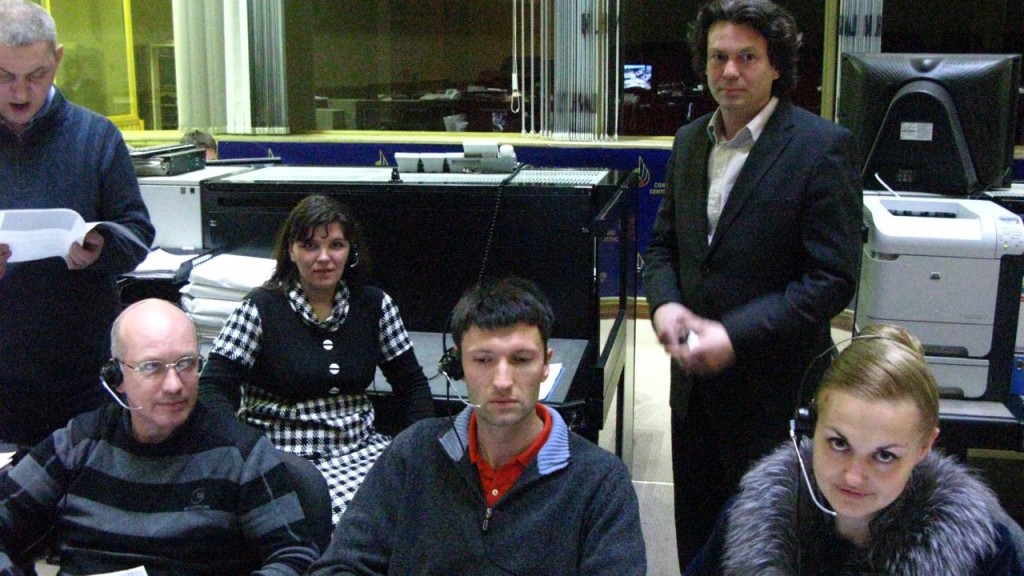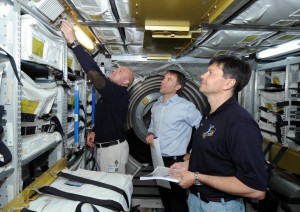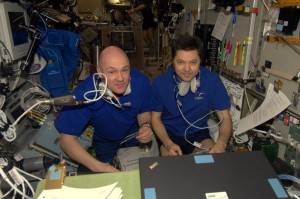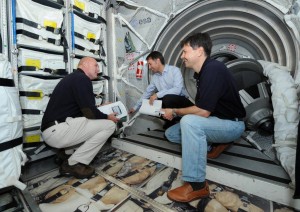Train like an astronaut: Try your hand at ATV on-board training
Editor’s note: Regular readers of the ATV blog will know that astronauts who oversee each ATV docking — and later use ATV while attached — undergo in-depth training at ESA’s European Astronaut Centre (EAC), Cologne, Germany. There, a team of expert trainers use high-fidelity simulators and mock-ups to quickly bring all ISS crew up to speed on how to work with Europe’s space cargo vessels during all phases of the mission, especially rendezvous and docking.
But a little-known aspect of ATV mission preparation is that the crew continue their training even in space. Why? Under regular circumstances of crew rotations and hectic training schedules between Houston, Moscow and elsewhere, initial ATV certification at EAC sometimes takes place up to half a year before they’re actually on board the ISS to carry out ATV operations.
Therefore, an effective on-board training (OBT) system aiming at maintaining ATV efficiency must be in place in order to provide critical refresher training and declare ‘crew readiness’ for ATV rendezvous and docking.
In fact, EAC and industry partners have developed a very high level of expertise in designing and developing on-board training modules. These require sophisticated 3D graphics and superb ‘ease of use’ for busy astronauts in orbit. Furthermore, EAC is responsible for all ground and on-board training for the European ISS contribution, primarily ATV and Columbus lab.
Today, we’re delighted to bring you a behind-the-scenes look at how on-board training is planned, managed and conducted by the experts at EAC. By special arrangements, we’ve also included links to two of the actual OBT training modules that are used by astronauts — and that are actually being used by ESA astronaut André Kuipers and Russian cosmonaut Oleg Kononenko on board the ISS last week and this week to prepare for docking.
Click on link to read full post and access the online training modules.
The ATV blog spoke with ESA’s Frank Nicolini, Head of the EAC Training Infrastructure and Facilities Unit and ESA’s representative to the multilateral ISS On-Board Training Working Group (OBTWG)
Q. What are some of the constraints to delivering effective on-board training to astronauts on the ISS?
A. Since simulators on board the ISS do not have the same degree of fidelity as the ones used at EAC during on-ground training, training techniques and tools must be adapted for use on Station. Preparing and conducting OBT sessions follows different standards than ground training. A high level of multilateral coordination involving multiple control centres and agencies is required before any lesson can be conducted in space. ESA’s training material — a dynamic simulator, computer-based training modules and 3D animated procedures for crew reference — must also be hosted on Russian as well as on US laptops.
Q. How does OBT fit into the overall ATV training that the crew must complete?
Initial ground training for ATV at EAC takes a total of two weeks to become a specialist for Rendezvous and Docking (RDV), Attached-Phase Operations and Water & Gas Transfer. Later, and shortly before launch, crew skills for the critical rendezvous procedures are again practised at Star City, Moscow, by GCTC (Gagarin Cosmonaut Training Centre) instructors. The final exam for the crew is done at GCTC approximately four weeks prior to launch with experts from EAC and GCTC.
Once in orbit, the astronauts undergo on-board training, again with experts from EAC and GCTC, shortly before docking. The crew will go through a set of lessons focusing on ATV docking, as well as hatch opening and ingress.
For the actual docking, two astronauts are assigned to monitor the automated approach of ATV to the ISS to ensure the vehicle stays within a predefined docking window. This basically includes visual monitoring of the approaching ATV and ATV and ISS systems monitoring. By that time, they will be fully prepared.
Q. How does OBT affect the astronauts’ daily routine on board the ISS?
Throughout OBT training sessions, daily life on board the ISS can’t simply be stopped; thus understanding and professional trust are key to completing a properly executed training session that does not hinder nominal operations for the orbital outpost. It’s important, for instance, that the crew and the trainers already know each other from previous ATV ground training at EAC and Star City. Planning, scheduling and flexibility are critical, and the training software itself has to perform as required.
Q. What does a typical OBT training session for, say astronaut André Kuipers, look like?
Following international agreement, and since ATV docks to the Russian segment of the ISS, OBT is conducted from the Mission Control Centre Moscow (MCC-M or TsUP). A typical session covers nominal ATV approach, where the crew reviews the nominal scenario for ATV rendezvous and docking. Next, they will review potential malfunction scenarios and refresh what they must do as crew for immediate actions.

EAC crew instructors Oleg Polovnikov (front left) and Lionel Ferra (front middle) are shown here during a training session in MCC-M from the Glavnij Operator console (Russian equivalent to NASA's CAPCOM and ESA's EUROCOM), operated by Elena Serova, a trained cosmonaut. These lessons are performed in both English and Russian language to ensure A. Kuipers and O. Kononenko are ready for ATV-3 rendezvous. Credit: ESA
Both André Kuipers and Oleg Kononenko, together with the Russian Flight Control Team, are practising this particular module last week and this week to be ready for ATV docking on 28 March. (Readers can try this module for themselves via the first RDV link below – Ed.)
ATV operations, though, do not stop at docking. We can also rehearse with the crew what happens once ATV is successfully attached. We’ve developed a set of 3D animated scenarios that cover a number of attached phase activities. (The second link below is for the ingress module – Ed.)
Q. What’s coming up in the future for your OBT programme?
Currently, ESA’s training material and 3D procedures are hosted on the ISS Fileserver accessible from the Space Station Support Computers (SSCs). The ISS crew have previously expressed a strong wish to access digital resources like OBT not only from laptops as is the case now but also from portable devices. To help make this happen, our Russian partners have already sent the first iPad to the ISS for crew personal use and additional testing. All partners are currently working on the selection and specification of portable devices.
ESA is now working to develop a first set of 3D training procedures; we already have some available for iPad/iPhone for detailed testing to support the fourth ATV mission.
Contact
Frank Nicolini
Head, EAC Training Infrastructure and Facilities Unit
European Astronaut Centre, European Space Agency
Linder Hoehe, D-51147 Cologne, Germany
EAC Tel. +49 2203 6001 311, Fax +49 2203 6001 302
Fran…@esa.int
Train like an astronaut – try it yourself!
Please note
1. These are, indeed, the actual on-board training modules used by the astronauts; as such, working through them takes time and, usually, the presence of a dedicated expert instructor. While there are some help files linked, we can’t, unfortunately, offer any online assistance to our keen ATV blog readers. Do your best on your own, and try not to bump ATV into the ISS, will you? 🙂
2. We’ve done our best to make these files accessible from, and work in, a general public web environment, which is not how they’re usually run, so there could be issues. If you have a Windows PC, Internet Explorer and a reasonable net connection, they should work for you. But they might not. Again, we can’t offer any online assistance/tech support.
3. The second module, Final Ingress, runs more like a traditional video game, and may be a bit more fun for home-based future astronauts.
4. Before starting, you’ll need to download and install the Cortona 3D viewer plugin for your Internet Explorer. Grab this via Cortona3d.com
Now, finally, to the modules (are you using IE?)!




 Automated Transfer Vehicle page
Automated Transfer Vehicle page ATV blog archive
ATV blog archive
Discussion: 3 comments
Hi,
wow these On-Orbit Procedures are fantastic. I always dreamt to have access to those data. Now we can really understand how this docking takes place from the astronaut perspective on the ISS. I wish there were be more procedures like this for example of the Columbus Module. Anyway ESA is taking here the first step to open up those procedures from all ISS Partners to us and I really like to say: Thank you for that. ISS Operations is a very complex topic that is very hard to make the general public more understandable. You are doing here the right step in the right direction.
Thanks, Ian! We’ll see what else we can make available here in the blog — once we have some time after docking, of course! — Daniel
This appears to be very interesting, bit restricted to Internet Explorer?, really? That is disappointing.